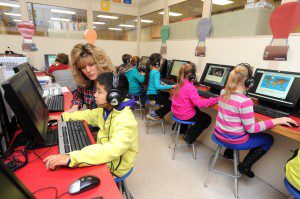
Kate McKenna, the coordinator of the Imagine Learning computer lab at Highland Elementary School, works with third grader Junhau “Henry” Wang, 8. (Photo by Carl E. Hartdegen)
WESTFIELD – Following presentations by Abner Gibbs and Franklin Avenue Elementary School Principals Chris Rodgers and Fran St. Pierre before the Westfield School Committee Monday evening, Highland Elementary School Principal James Kane also addressed his school’s progress.
Programs such as Imagine Learning have played a major role in Highland’s school year thus far, earning them a major distinction.
“Highland has been using (Imagine) for the past three years and this year Highland was awarded the 2014 Imagine Nation Top 50 School award,” said Kane. “We’re one of the top 50 schools in the country using the Imagine Learning software. It’s been utilized during our extended day program and summer school program, which serviced over 200 students.”
He added that the school has 200 program licenses for it’s student body, one of the most diverse in the city.
“Our demographics changed considerably over the past three or four years. The level of need with our families and the greater school community is growing at an alarming rate,” said Kane. “We’re helping our families with clothing, gift cards and food items year round.”
Kane stated that the school counts students from Bhutan, Syria, Iraq and several families from Sri Lanka as recent additions to the school’s student body, which already has a considerable Russian population.
“We are a real world school with an incredible diversity, which I think every child benefits from,” he said. “We have just over 400 students in the building and for just under 200 of them, English is not their first language. It’s a challenge but it’s very exciting.”
Last year, the school implemented the Envisions Math program and modeled it’s math block scheduling after the Bay State Reading Initiative (BSRI) literacy block.
“As we move forward, we want to increase our ST (Spatial Temporal) math usage in third and fourth grade and with the ST Math homework component,” he said of the computer software program which utilizes spatial temporal reasoning to teach math concepts.
Highland Assistant Principal MaryClaire Manning said that the school is trying to teach behavioral expectations in a similar manner to how the school implements subject curriculum.
“At Highland, instead of focusing on what not to do, we focus on our PAWS – Practice responsibility, Always be safe, Willing to learn and Show respect,” she said. “We’re in our second year of implementation and we’ve made significant progress this year.”
Manning said that there is a Positive Behavioral Intervention and Supports (PBIS) assessment called “The Benchmarks of Quality” in which the school showed a 61 percent improvement on in 2014.
“Last year at this time we scored an eight,” Manning said. “69 (percent) doesn’t sound so good, but compared to eight, we’ve made significant progress and a lot of it has to do with our team – we have 12 Highland staff members on our PBIS team.”
The school has also formed subcommittees to plan events and fundraising, along with a host of communications and data specialists, to help create a more cohesive school environment among faculty and staff.
“We continue to move forward to support our students, staff and community families,” said Kane.


